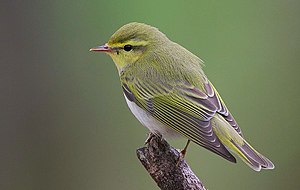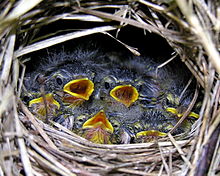Wood warbler
| Wood warbler | ||||||||||||
|---|---|---|---|---|---|---|---|---|---|---|---|---|

Wood warbler ( Phylloscopus sibilatrix ) |
||||||||||||
| Systematics | ||||||||||||
|
||||||||||||
| Scientific name | ||||||||||||
| Phylloscopus sibilatrix | ||||||||||||
| ( Bechstein , 1793) |
The wood warbler ( Phylloscopus sibilatrix ) is a bird art of the genus of Laubsänger ( phylloscopus ) from the family of Laubsänger-like (Phylloscopidae). No subspecies are distinguished.
description
The wood warbler is about eleven to thirteen centimeters long, has a wingspan of 19 to 24 centimeters and a weight of about eight to thirteen grams. The little bird has a white belly, a yellow throat and a yellow stripe above the eyes , the back is green, its chest is yellowish white. Males and females have the same coloration. Life expectancy is up to eight years. The wood warbler is the largest of all native warbler species. His call sounds like "sib" or "tüh". The singing consists of two stanzas, which are also performed independently of each other: The first, very characteristic, sounds like a sewing machine starting up ( is like an accelerando ), and the second is a sloping “düh-düh-düh ... ".
Distribution area and habitat
The wood warbler is a breeding bird of the deciduous forest belt in the west of the Palearctic and a long-distance migratory bird . He lives in light deciduous and mixed forests, beech forests and parks. The distribution area extends from Great Britain over the southeast of Norway and Sweden as well as Finland to the western edge of Siberia. The southern limit of distribution runs through the south of France and the south of Bulgaria, Moldova and Ukraine. In Central Europe, the wood warbler is widespread in deciduous forest stands and occurs from the lowlands to the Montan level. In the canton of Jura it occurs occasionally up to altitudes of 1,400 meters, in the Alps, however, it rarely rises above 1,300 meters.
From April to September it is present in almost all of Central Europe , its winter quarters are in tropical Africa . Departure time and direction of movement are innate.
nutrition
The wood warbler feeds on spiders , mollusks, insects and their larvae . In autumn he also eats berries occasionally .
Reproduction
The sexual maturity occurs after one year. Wood warblers predominantly live a monogamous brood or seasonal marriage. After the onset of incubation, between thirty and sixty percent of the mated males begin to woo a second female in a smaller second area.
The main breeding season is May to July. The oven-shaped nest , built from stalks and grass, is well hidden in the undergrowth. The female lays six to seven eggs , which are incubated for 12 to 14 days. The young birds stay in the nest for 12 to 13 days after hatching. The European population is estimated at around 7 million breeding pairs.
supporting documents
literature
- Hans-Günther Bauer, Einhard Bezzel , Wolfgang Fiedler (eds.): The compendium of birds in Central Europe: Everything about biology, endangerment and protection. Volume 2: Passeriformes - passerine birds. Aula-Verlag Wiebelsheim, Wiesbaden 2005, ISBN 3-89104-648-0 .
Single receipts
Web links
- Phylloscopus sibilatrix in the Red List of Threatened Species of the IUCN 2008. Posted by: BirdLife International, 2004. Retrieved on January 17 of 2009.
- Videos, photos and sound recordings on Phylloscopus sibilatrix in the Internet Bird Collection
- Wood warbler feathers

